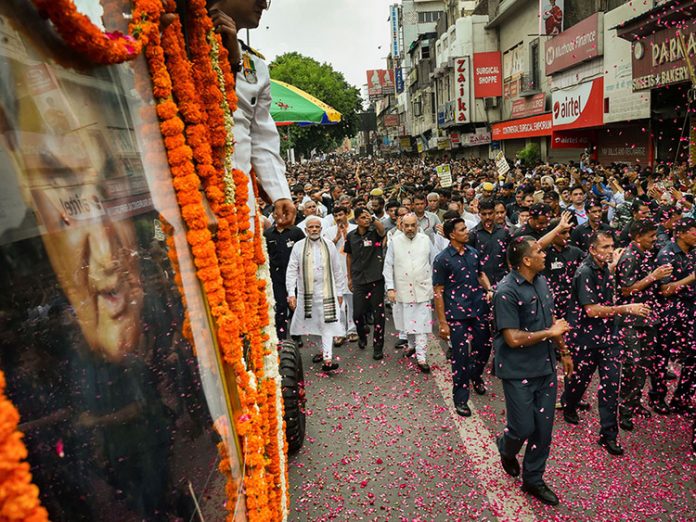Modi Government: Is the Hindu identity at the centre-point of Indian polity? Will the Modi model of politics work in future?
Are more Indian voters shifting to the Right since the Modi era began? Is polarisation on all key issues related to caste, religion, economy and governance becoming deeper?
Recently some of these questions have been in sharp focus in a couple of excellent books published on the idea of Hindu Rashtra, the fascinating subject of Vajpayee-Advani Jugalbandi (partnership) and the study of the evolution of the RSS over the century.
A range of authors from Aakar Patel (Our Hindu Rashtra), Vinay Sitapati (Jugalbandi), Shakti Sinha (Vajpayee) to Vijay Trivedi (Sangham Sharanam Gachchami) have written on the most pressing issues facing India.
Two ongoing significant political events stand out.
The campaign of the West Bengal assembly election is raising political heat in Delhi. If the BJP manages to win West Bengal and even if the Mamata Bannerjee-led TMC fails to stop BJP getting an impressive political space in Bengal, the Modi model of politics is expected take a giant leap forward.
If pre-election campaign in West Bengal is any indicator, we are in for some very intense and aggressive polls coming up.
Both, the BJP and the TMC are playing with the baser instincts of the voters.
BJP has the funds, resources and determination to defeat Mamata Bannerjee. It seems set to decimate the Left block and Congress. Bengali voters are likely to be more polarised before the voting day.
Another political development is even more significant. Supreme Court of India in its recent remarks has been exceptionally harsh on Modi government for its handling of the farmers protest.
Chief Justice S A Bobde questioned the Centre’s strong opposition to the court’s suggestion that the implementation of the farm laws enacted in September be kept on hold for the time being. On 12, January the Apex Court went head and froze the law.
This historic decision by the top court has come as an embarrassment for the Modi government. Laws passed by the elected representatives was under scrutiny due to the pressure of disgruntled groups.
Arguments between two sides (farmers versus government) in the court of the law have resulted in a not-so-legal conclusion that Modi government did not consult stakeholders enough before making the law.
This is as vague conclusion as it can be. The fact is that during negotiations the government revised its stand, for good of all sides. Perhaps the government was late to take into consideration both — farmer politics and politics of Punjab.
It tried to reverse many crucial clauses of the new laws — like imposing taxation on the trade conducted outside the designated market area. Mandis and the farmers are now allowed to settle legal issues in the regular courts.
It is clear that in the India of 2021 sharp polarisation on most issues is a regular phenomenon. Whether it is the issue of the new Farm Laws or the Citizenship Amendment Act or striking down of Article 370, polarisation within the country is so sharp that it reminds people of Vajpayee’s political model.
The famed Vajpayee model
Three-time Prime Minister Atal Bihari Vajpayee left behind a style of governance which carefully constructed a perception that the government wants consensus. The Vajpayee model was the workable mix of some elements of the Nehruvian diplomacy, recognition of the Hindu identity and consciously avoiding provocation.
A.S. Dulat, former chief of India’s RAW and Vajpayee’s adviser on Kashmir calls it, ‘the Samosa-Jalebi model.’
Vajpayee government’s handling of the Hurriyat politics is a case in point. When the most-awaited meeting happened between then Prime Ministrer Vajpayee and Kashmir’s separatist leadership in the PMO, the focus was on posturing and messaging while offering Samosas and Jalebis!
Vijay Trivedi, author of Vajpayee‘s biography and the Sangh’s 100 years of history told Gulf News, “I think the Vajpayee political model is more relevant for future governments. We have to understand the nature of Indian society. We believe in consensus and like to discuss each and every issue. Vaypayee ran his coalition government for six years and took very important decisions like India’s nuclear tests, Lahore declaration etc but took everyone along.”
There was political resistance and there were protests then too but Vajpayee didn’t antagonise different political forces.
An impressive record of victories
Modi, despite of electoral setbacks in few states, has kept his record of victory impressive. But, at the same time this government is witnessing exceptional opposition on the street.
Modi and the BJP are getting thumbs up from voters but the polarisation within the voters has boiled down to the farm agitation type of situation.
Stalemate on the Farm Bills and government’s inability to end the agitation proves that Modi needs, ‘Samosas and Jalebi’ politics. The BJP needs to reinvent the political language for its adversaries within the framework of ‘Insaniyat and Jamooriyat’ (humanity and democracy).’
Indian democracy can create problems even when the government is acting within the legal framework.
As one of the former ministers of the Vajpayee cabinet noted, “only two model of politics will remain for the country if the BJP wins West Bengal. The Modi-Shah model and the Vajpayee model of politics.”
Vajpayee model worked when the BJP was leading the coalition government without having a majority. Modi government has an absolute majority therefore its political model is different.
However India’s ongoing polarisation and extreme discourse suggests that it is time to inject elements of Vajpayee model.
Also Read: Dubai: Can my wife offer online cooking classes without a permit?
Anushka and Virat’s daughter Anvi will live in such a luxurious house of crores, see INSIDE photos




